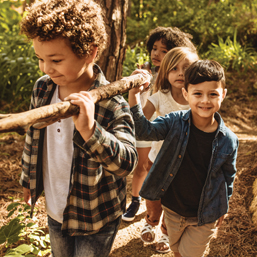
The art of playing in nature has been lost for many of us. Our lives have become busy with many competing demands and expectations. We are busy with work, school, and structured extracurricular activities. When we have free time, we are staying in our homes and on screens at a higher frequency than ever before. These lifestyle changes have impacted child development.
Today, we are seeing many of our children struggling with focus and attention. They are experiencing difficulty completing tasks and moving through routines without frequent adult reminders. Many of our children are experiencing a lack of motivation to initiate activities. They are having difficulties coping with things they find challenging, struggling to engage in creative play, and are having trouble finding ways to entertain themselves when screens are not available. If this sounds familiar, you are not alone!
There is a mountain of research showing evidence that nature play positively impacts children’s physical and mental health, as well as increases their cognitive and social well-being. Playing in nature increases a child’s self-awareness, enhances attention, and improves self-confidence as they learn to navigate new terrain.
Nature is not a structured or static activity. Nature play is dynamic and introduces novel experiences in a way that indoor sedentary play cannot. Learning through physical play creates new neural pathways leading to stronger overall development.
While outdoors, children are learning to attend to their environment and to negotiate each step or climb according to their developing physical abilities. With each new outdoor challenge accomplished, an increase in self-esteem is often observed.
Playing in nature also supports children to develop social-emotional regulation, increase creativity, and improve overall mood. Being in nature slows life down, reducing overstimulation. The slower pace allows children to interact with their environment and others with increased intention. When we are not overloaded with stimuli, our creative thinking is free to engage.
With time and patience, imaginations ignite and children engage with nature as if it were their very own playground.
How do we get our children started with nature play? We could start with activities such as having lunch in our backyards, having a playdate at our nearest green space, or going for a walk in a city park. Once you are outside, encourage your children to play in the puddles, climb a tree, roll down a hill, create a nature scavenger hunt, collect rocks to paint, or identify animal prints on a walk. You could have your child participate in building a fire for a marshmallow roast, construct a shelter with fallen branches, skip rocks on a pond, or cast the fishing line. For families who struggle to get outside, you could have your children attend an outdoor group or camp.
It should be acknowledged that most of our children will complain when asked to shut off their screens and head outside. It can be helpful to schedule time in our busy schedules for outdoor experiences. Making nature play times predictable allows everyone to prepare and children to know when they will gain their screen back. Anticipate having to work through the initial discomfort while everyone adjusts. It may be uncomfortable the first few times when boredom hits and our children claim to not know what to do. They will likely beg and plead for our help to ‘save’ them from their feelings of discomfort. Stay committed. The best thing we can do is wait… creativity and a desire to explore will eventually set in!
As our children start to generate new ideas during nature play, they might take some risks (climbing a tree or jumping from one large rock to the next). While these risks may feel scary to parents, it is in these moments when our children are learning the most. Help your child by asking questions about their plan (“how do you plan to get from one rock to the next?”).
Pause them to assess risk (“take a look at this branch, how do we know it is strong enough to hold you?”). Try to avoid giving them the answers or making the plans for them. Teach your child to test out their theories by moving forward slowly and thoughtfully. At the same time, allow them the space to learn from trial and error (as long as the risk of harm is low).
Children benefit from making small errors, which sometimes results in getting dirty, small scrapes and bruises. These moments support our children in learning their physical limits, develop resilience, and contribute to increased confidence as they learn to navigate their world independently.
If we start small and slowly build up our children’s tolerance and joy for nature play, we may find ourselves surprised at the positive changes we see. The benefits in our child’s physical and mental health, as well as in their cognitive and social well-being will be well worth the struggle we felt while helping our children make this shift.
Jenny has worked with children and families for over 20 years in an individualized, goal-focused way to support positive change and increased functioning. Jenny’s mission is to get to know each of her clients in a way that allows her to honor their unique context and build on existing strengths and abilities. Learn more at sheldonpsychology.com or contact Sheldon Psychology Group at This email address is being protected from spambots. You need JavaScript enabled to view it..
Calgary’s Child Magazine © 2024 Calgary’s Child